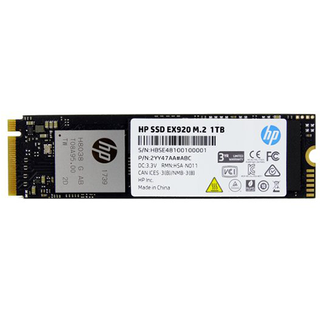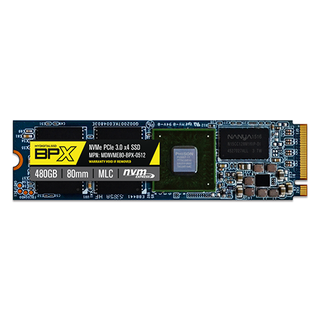Samsung 970 EVO SSD Review: The 64-Layer Refresh
Why you can trust Tom's Hardware
512GB Performance
Comparison Products
The 960 Pro comes with MLC flash, while the PM981 has the same controller and TLC flash as the 970 EVO. The PM981 is the system builder version of the 970 EVO and is currently shipping in systems from Dell, Lenovo, and others. It comes with different firmware and drivers.
We also included the 512GB HP EX920 and the Intel 760p. Both come with the SMI SM2262 controller and Micron/Intel 64-layer flash. The Plextor M9Pe also falls into this category with Toshiba’s 64-layer flash. We used the M9PeY model that comes as a half-height, half-length add-on card with a massive heatsink.
The Toshiba RD400 and MyDigitalSSD BPX come with MLC flash. The WD Black PCIe represents the old world when NVMe SSDs still used 15nm planar (2D) TLC flash.
Testing Details
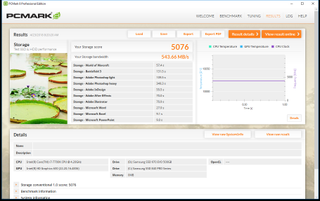
In PCMark, we recorded a 42 MB/s increase in storage bandwidth just by swapping out the Samsung driver with the in-box Microsoft driver. In MobileMark, our battery time increased by 20 minutes with the Samsung custom NVMe driver. This shows that Samsung modified its driver to slow the drive, which conserves power.
Sequential Read Performance
To read about our storage tests in-depth, please check out How We Test HDDs And SSDs. We cover four-corner testing on page six of our How We Test guide.


The 970 EVO has phenomenal QD1 performance, but only scales slightly at QD2 and QD4 before reaching full speed at QD8.
Sequential Write Performance


The 970 EVO starts in the same range as the other Samsung SSDs at QD1, but it levels off at 2,500 MB/s at QD2. The 970 EVO is roughly 600 MB/s faster than the PM981. It’s also roughly 400 MB/s faster than the 512GB 960 Pro.
Sustained Sequential Write Performance
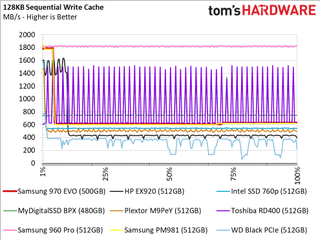
The three Samsung SSDs start the test at ~1,800 MB/s. The 960 Pro with MLC flash holds steady throughout the entire test, but the 970 EVO and PM981 both drop to native TLC speeds once the buffer is saturated. After the Intelligent TurboWrite burst, the drives fall further to ~600 MB/s.
Random Read Performance



The EVO eclipses 12,000 IOPS at QD1 and scales well as we intensify the workload.
Random Write Performance



The PM981 suffered a big drop in random write performance with the older Samsung driver, but we're using the new version for the 970 EVO. That opens up a 16,000 IOPS gap at QD1. The 970 EVO hits a performance wall around 85,000 IOPS with the new driver, which is consistent with the other models we tested.
The random write performance test is usually little more than a footnote. Most of these drives absorb the brief writes to the SLC buffer at very high speeds. Operating systems issue far more read requests than write commands, but writes can bog the system down if it has to wait for a completion before performing another task.
70% Mixed Sequential Workload
We describe our mixed workload testing in detail here and describe our steady state tests here.


The 970 EVO performs well with mixed workloads thanks to the new five-core controller. We also observed good performance with the PM981, which uses the same controller. The OEM version appears to be slightly faster at lower queue depths, but both SSDs are fast enough that you wouldn’t notice the difference during normal use.
70% Mixed Random Workload


Again, we found strong performance at low queue depths in our mixed random workload. The 970 EVO hit the same wall around 85,000 IOPS.
Sequential Steady-State



The 970 EVO was not designed for write-heavy workloads, but its performance and endurance match or exceed some of the other products designed for these workloads. It is certainly capable of being a low-cost 970 Pro alternative.
Random Steady-State


We ran into issues with peak random performance earlier on this page, but the drive performs well when we push it into a steady-state condition. The 970 EVO trails only the 960 Pro and its performance are nearly as consistent, too. We would recommend this drive for use in a consumer SSD array with two drives hanging from an Intel chipset.
PCMark 8 Real-World Software Performance
For details on our real-world software performance testing, please click here.










We briefly discussed the difference between the Microsoft and Samsung drivers and how they impact PCMark 8’s application tests. The specifications show the 970 EVO should outperform every other drive in this comparison, including the 960 Pro. Even with the faster driver installed, the 970 EVO comes up short.
Application Storage Bandwidth

The Samsung driver delivered an average score of 501.38 MB/s, but the Microsoft driver reached up to 543.66 MB/s. Even with the faster driver, the 970 EVO can't pass the MyDigitalSSD BPX and less-expensive HP EX920.
PCMark 8 Advanced Workload Performance
To learn how we test advanced workload performance, please click here.



The 970 EVO recovers quickly after a heavy workload. We focus on the recovery phase because it represents typical desktop performance. The three Samsung SSDs take the lead, but the Intel SSD 760p and MyDigitalSSD BPX (with MLC flash) aren't far behind. The HP EX920 has issues during garbage collection routines, and the resulting latency reduces throughput.
Total Service Time



The service time tests show strong performance during both light and heavy workloads. The 970 EVO dominated the recovery phase.
Disk Busy Time
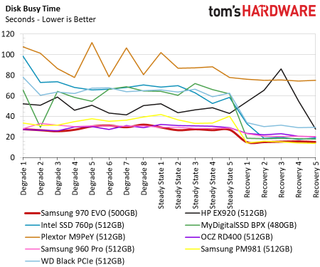
The disk busy time test measures how long the drives worked to complete the tasks. Faster drives satisfy I/O requests sooner, thus facilitating a faster transition back into power-conserving low-power states. The Samsung 970 EVO delivers the best performance and even manages to outperform SSDs that use planar MLC flash.
BAPCo SYSmark 2014 SE Responsiveness Test


The 970 EVO performed better in our responsiveness test than the 1TB model. The 970 is also faster than the previous-gen EVO and the OEM model with the same controller and flash.
BAPCo MobileMark 2012.5 Notebook Battery Life
To learn how we test advanced workload performance, please click here.


We originally ran this test with the Samsung's custom NVMe driver. In the past, the driver reduced notebook battery life by accelerating disk performance. This time around, we scored better results with the Microsoft NVMe driver. The 970 EVO delivered 338 minutes of battery life.
MORE: Best SSDs
MORE: How We Test HDDs And SSDs
MORE: All SSD Content
Stay on the Cutting Edge
Join the experts who read Tom's Hardware for the inside track on enthusiast PC tech news — and have for over 25 years. We'll send breaking news and in-depth reviews of CPUs, GPUs, AI, maker hardware and more straight to your inbox.
-
WINTERLORD id assume if you already have a 960 evo, then its not yet worth the upgrade meaning you wouldnt notice a difference in real world performance?Reply -
rinosaur So whats next? PCI x8? I just got a SM2262 drive and it outbenches my old SATA SSD 5 times over but I can't really tell even on boot up. I wish there was a Battlefield 1 benchmark since BF3 is pretty old and the maps will be tiny in comparison. At the same time I don't know what the bottleneck is when loading multiplayer maps. Even small games like HotS could not possibly be utilizing the old 500MB/s drive to the max since it takes like 15 seconds to get to 100% with low CPU/memory usage.Reply -
Co BIY In the Application Storage Bandwidth chart the Samsung 970 EVO is mislabeled as a Plextor product.Reply -
modeonoff I cannot find it in major online stores in North America yet. Don't know about availability. When it becomes available, will the current SSD prices drop?Reply -
ATI9800Pro Where can I get that Plextor 970 EVO 2TB in the Application Storage Bandwidth chart ? :DReply -
mikeynavy1976 Similar question to ERN88. I currently have a 850 EVO (M.2) in a desktop (i7-7700k w/ 16GB RAM) and I don't notice any real world difference from a Dell XPS 13 w/ older NVMe drive. Benchmarks, obviously, show the NVMe considerable faster. Is it still only worth upgrading from SATA to NVMe (SSD of course) with specific workloads?Reply -
Darkbreeze I wouldn't exactly call the MX500's read/write speeds of 560/510 MB/s and 95/90k IOPS "catching up". It surprised me when I read that so I went to double check. The MX500 is not even as fast as the 960 EVO (Actually, it's less than half as fast) much less the 970, and it's more expensive, at 121.99 being the least expensive I could find one for, although the double storage space is nice, users looking for fast drives are more worried about performance than they are about doubling the capacity of a much slower drive.Reply
Unless you can show conclusive performance versus pricing, with links, I'm afraid I can't agree with the validity of some of the information shown here.
